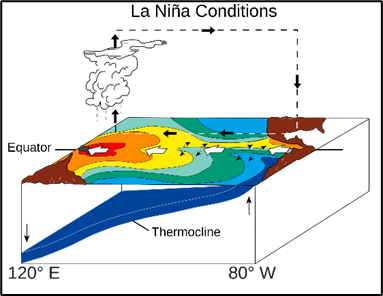Mains Daily Question
June 14, 2023
How does El Niño differ from La Niña? Elaborate on the major environmental and socio-economic implications of El Niño on India.
Approach:
Introduction: Give an introduction about ENSO.
Body: Give the difference between El Niño and La Niña and a few points about the implications of ENSO on India.
Conclusion: Conclude by bringing the step taken by World Meteorological Organisation (WMO).
Answer:
El Niño and La Niña are two extreme phases of the El Niño-Southern Oscillation (ENSO) cycle, which refers to the fluctuations in sea surface temperatures and atmospheric conditions in the tropical Pacific Ocean. El Niño is characterized by unusually warm ocean temperatures in the central and eastern Pacific
Differences between El Niño and La Niña:
|
El Niño |
La Niña |
|
● It refers to the warming of sea surface temperatures in the central and eastern Pacific Oceans. ● During El Niño, trade winds weaken, warm water accumulates in the central and eastern Pacific, and the thermocline deepens. ● This leads to reduced upwelling of nutrient-rich waters, causing a decrease in fish populations in affected regions.
|
● It refers to the cooling of sea surface temperatures in the central and eastern Pacific Oceans. ● La Niña events occur when the trade winds strengthen, pushing warm surface waters towards the western Pacific. ● This brings cooler waters to the surface in the eastern Pacific, resulting in enhanced upwelling and higher productivity of marine life.
|
Implications of EL Nino event in India:
- Droughts and Reduced Monsoon Rainfall
- El Niño disrupts the standard patterns of the Indian monsoon. The warm oceanic conditions in the Pacific alter the atmospheric circulation, leading to the suppression of rainfall over India.
- This can result in agricultural droughts, water scarcity, reduced crop yields, and impacts on food production. Farmers heavily reliant on monsoon rains often face financial losses and agricultural distress.
- Heatwaves and Extreme Weather Events
- El Nino alters atmospheric conditions and can lead to increased temperatures and prolonged heat waves, affecting public health, agricultural productivity, and energy demand.
- Moreover, El Niño influences the formation and intensification of cyclones in the Indian Ocean, potentially leading to increased cyclonic activity and associated risks.
- Forest Fires and Biodiversity Impact
- El Niño can contribute to the occurrence and severity of forest fires.
- The drier conditions and reduced precipitation associated with El Niño increase the risk of wildfires, destroying forests and losing biodiversity.
- Forest ecosystems and wildlife habitats are particularly vulnerable during such events.
- Socio-economic Challenges
- The environmental impacts of El Niño, such as droughts, reduced crop yields, and water scarcity, have significant socio-economic implications.
- The agricultural sector, which employs a substantial portion of India's population, is adversely affected, leading to income losses, rural distress, and increased food prices.
- Additionally, water scarcity affects drinking water supplies, sanitation, and industrial production, further straining economic activities
El Niño has significant environmental and socio-economic implications in India, including droughts, reduced monsoon rainfall, heatwaves etc. Therefore, World Meteorological Organisation (WMO) launched the El Niño-La Niña Update, a monthly report that provides information on the current state of ENSO and its potential impacts.



